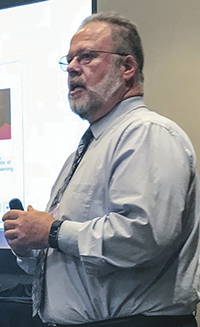Beyond Episodic Compliance
August 01, 2020
How three school districts are using accreditation to leverage continuous improvement in different ways

As accreditation has evolved in recent years beyond episodic compliance, district leaders now commonly use feedback from the process to better understand how well they and their schools are performing and to address blind spots. In Farmington and other
school districts, leaders have recognized the power of the accreditation process to create ongoing systems to monitor, assess and improve teaching and learning beyond the accreditation cycle. Leaders like Schmidt also are leveraging key components
of accreditation — including systematic classroom observations and data analysis — to introduce and reinforce continuous improvement practices of their own.
Farmington educators have followed an instructional model steeped heavily
in the classroom practices of Charlotte Danielson and Robert Marzano for more than a decade. The model has become so entrenched within the district that it is known as “The Farmington Way.”
Although Farmington’s approach
preceded Schmidt’s 2015 arrival as superintendent, he recognized the importance of a “recommitment to the process,” as he put it. Affirming the district’s instructional model was particularly important, he adds, given ongoing
staff turnover. “The Farmington Way was a concept introduced more than 10 years ago,” he says. “Over time, in a district of 1,900 employees, people can forget.”
This Content is Exclusive to Members
AASA Member? Login to Access the Full Resource
Not a Member? Join Now | Learn More About Membership
Strategies That Work

School systems can use the accreditation process to fuel internal improvement. Several strategies can drive change.
- SELF-ASSESSMENT. When the Norris, Neb., School District had staffers complete a self-assessment as part of the school district review process, they rated a wide range of quality indicators 3’s or 4’s on a four-point scale.
Even so, the process reinforced the areas of improvement external reviewers would later identify.
“We had to really reflect on our original responses,” says John Skretta, the former superintendent in Norris. “Realistically, everything we needed to know was, in one fashion or another, embedded in the self-assessment.” - OBJECTIVE DATA. Classroom observations and survey data generated by external reviews provide objective, third-party confirmation of where practices are and are not being implemented with fidelity. Feedback is rarely a surprise, school leaders say, but external accreditors’ respected voice lends credibility to calls for change.
- PRIORITIZATION. External reports pinpointing the most critical areas of improvement can help focus internal efforts. “One thing we tried to do is manage how many objects of change we have in the system at any given time,” says Pamela Swanson, superintendent of Westminster Public Schools in Colorado.
- ADDRESSING POINTS OF PRIDE. While most districts have practices or cultures that define them, the outside perspective accreditation brings can shine a light into areas where assumptions fall short of reality. In Westminster, Colo., classroom observations revealed that despite widespread staff and community support for competency-based education, implementation was inconsistent throughout the district, especially in the grades that had adopted it most recently.
- LOOKING BEYOND CLASSROOMS AND BUILDINGS. In Farmington, N.M., parent surveys conducted as part of the district review revealed challenges connecting with the community. As a result, leaders improved central-office communications and consolidated administrative functions and staff from a half dozen buildings throughout the city into a “one-stop shop.”
- LEVERAGING ACCREDITATION PRACTICES. Many districts, including Farmington and Westminster, have continued stakeholder surveys and classroom observation protocols from external reviews as part of internal improvement efforts. “Kids and teachers and principals are so used to people looking at things, it’s just common practice now,” says Oliver Grenham, Westminster’s chief education officer.
- CELEBRATING SUCCESSES. Accreditation feedback often reaffirms areas of excellence within a school district. As with evaluations of individual educators, it’s important for leaders to communicate successes as well as areas for
improvement.
“It’s a wonderful means of reaffirming for schools what they are doing right,” Skretta says. “It recognizes how hard you’re working and where you’re making a positive impact.”
— MARK ELGART
Advertisement
Advertisement
Advertisement
Advertisement



